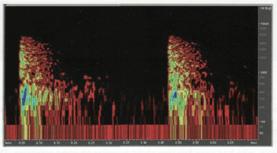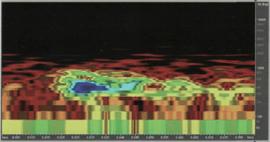The SPR (Society for Psychical Research) published an article from Dr Barrie Colvin B.Sc., Ph.D., in which Dr. Colvin talks about a possible scientific evidence of a poltergeist knock.
Although the claim itself does not sound all too interesting, looking at the collected evidence, one can quickly appreciate Dr. Colvin’s discovery. Dr. Colvin was able to record a supposed poltergeist knock, and compare that to one produced by ordinary means and the results are impressive.
“…Whilst the two types of rap sound rather similar, they are actually acoustically different, although the effect is only made apparent when the recordings of raps are submitted to detailed analysis. The sample involved 10 separate recordings recorded on different recording apparatus. In each of the recordings, when subjected to acoustic analysis, a particular sound pattern is detected which so far remains unexplained. Attempts to replicate this pattern in ordinary ways have so far been unsuccessful. The essential difference between these raps and those produced by normal means lies in the details of their sound envelope.”
Dr. Colvin’s discovery opens the door to many theories on the poltergeist phenomenon. Are the knockings and raps that one hears in a supposed poltergeist case a product of the acoustics of physical objects? Or are these sounds attributed to environmental factors, much like the theory for residual hauntings in which it is said that sometimes the environment (lei lines, quartz, lime, EMF) can cause a “recording” from images of the past; which in turn can arbitrarily project onto thin air?
Full article: Society for Psychical Research
27 commentsParanormal rappings associated with apparent poltergeist activity have been described for many hundreds of years. It is only now that an interesting pattern has been discovered within the fine detail of the paranormal rapping sounds. No explanation can be found for this pattern at present.
The current edition of the Journal of the Society for Psychical Research (SPR), a learned publication dating back to 1882, carries an article by scientist Dr Barrie Colvin B.Sc., Ph.D., showing instrumental evidence for an inexplicable and objective banging sound detected in recordings made during alleged poltergeist activity.
Whereas raps and knocking sounds produced by ordinary means exhibit a normal acoustic pattern, those recorded in alleged poltergeist cases show quite a different sound signature.
Dr Colvin has analysed recordings of alleged poltergeist knocking obtained from around the world over a 40-year period. The earliest was a recording made by a local physician at Sauchie (Scotland) in 1960 and the most recent was obtained from a poltergeist case at Euston Square, London in 2000.
Whilst the two types of rap sound rather similar, they are actually acoustically different, although the effect is only made apparent when the recordings of raps are submitted to detailed analysis.
The sample involved 10 separate recordings recorded on different recording apparatus.
In each of the recordings, when subjected to acoustic analysis, a particular sound pattern is detected which so far remains unexplained. Attempts to replicate this pattern in ordinary ways have so far been unsuccessful.
The essential difference between these raps and those produced by normal means lies in the details of their sound envelope.
In the case of a normal rap, the sound (which often only lasts a few milliseconds) starts loudly and decays over a period of time. The loudest part of the sound is right at the beginning. In the case of a poltergeist rap, the loudest part is near the beginning of the sound – but not at the very beginning. The rapping sound starts relatively quietly and works up to a maximum before it then starts to decay. This effect has been seen in all ten of the poltergeist cases studied.
The question arises as to how such a sound is generated. There is evidence which points to the sound arising from within the structure of a material rather than from the surface of it, as would be the case with a normally-produced rapping sound. This phenomenon will be examined further in future investigations of poltergeist activity.
Dr Colvin states: “Ever since my personal involvement in the investigation of a rapping poltergeist at Andover, Hampshire, in which it was absolutely clear that no normal explanation could account for the observed phenomena, I wondered whether the recorded raps were in any way different to those produced by normal methods. It is now clear that they are indeed different”.
Among the samples submitted for analysis were recordings made in the famous Enfield poltergeist case in north London during 1977-79.
Dr Colvin’s research is published in his article ‘The Acoustic Properties of Unexplained Rapping Sounds’ in the Journal of the Society for Psychical Research [2010] Vol 73.2 Number 899 pp 65-93.
The SPR holds no corporate opinions.
Full article: Society for Psychical Research






